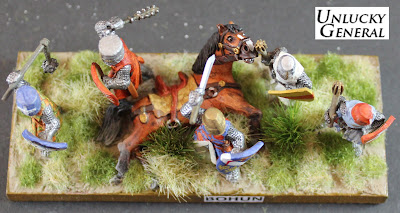Moving Along the Downs
 | |||
| Third tone: a dry brush of lighter green. |
Straight into it, I hit the tracks with a base coat of mid-earth brown, smearing it at first with a thick craft brush then worked it into the fabric with plenty of water. The paints reactivated with the water and I got a very pleasing ochre effect in the main. I didn't care about being too finicky as I expect the grasses to the sides will be slightly dusty in high summer. In any event the next step is a generous dry brushing of light cream and then a highlighting dry brush of white in keeping with the chalk surface.
The top two shots are using my wide angle zoom lens on a macro setting (not my macro lens) assisted by what was left of the sunlight with some assistance with the overhead lights. The next shot is using the automatic setting (not macro).
The above is the four-sixths layout (arrayed for painting) and now that it's coming together one thing stands out to me. Don't get me wrong, I'm pleased with the results thus far but the contours are pronounced because I never 'filled in' between the foam levels. I suspect for wargaming purposes it might be useful but my next terrain build will benefit from this oversight. Beause the sun is setting to the rear of the shot, the shadows cast a disticly terraced aspect to my eye. Anyway, other than the tracks, worn patches were similarly browned-up for the windmill site and the town edge (foreground).
Using the flash, you get a better idea of the relative brightness and colour in line with its appearance in daylight. The keen eyed will notice some lift at the edges which require Selley's Quick Grip for a permanent solution. After painting, I'll sow a scattering of permanent shrubs at the base of some of the contours to break it up further, being sure to fix them with a strong bond. I'll have to wait a couple of days before finishing the tracks and heavy traffic areas and then I have to sort out the flat and the marsh edge.






Comments